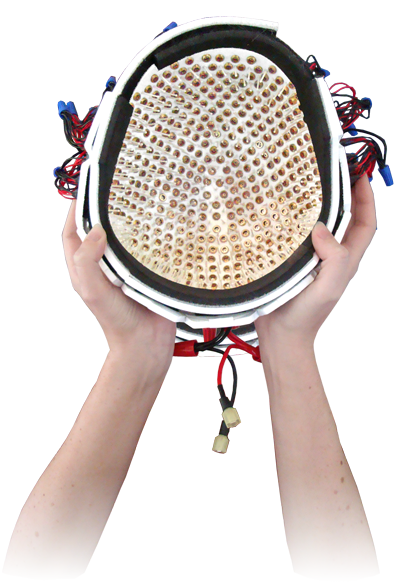“Would You Take a Knife to a Gun Fight?” Laser Light vs. LED Light… the DIFFERENCE explained!
.jpg)
It takes REAL LASERS to make a profound impact on hair loss for several very real reasons explained in this article!
It takes REAL LASERS to make a profound impact on hair loss for several very real reasons explained in this article!
 You know what a laser is. It's really a magical experience to look at one! It sparkles, dances around, and looks like it's ALIVE!!!
You know what a laser is. It's really a magical experience to look at one! It sparkles, dances around, and looks like it's ALIVE!!!Well... what about L.E.D's? Wouldn't that be the same thing? I mean, L.E.D.'s are cheap! Umm... what are L.E.D.'s exactly anyway?!
L.E.D.s are probably right in front of you. If you are on a desktop/laptop computer, those are the lights that tell you when your computer is on and the caps lock key is pressed. They are DEAD looking! It's the magic looking light of lasers that give the magic results --and head-to-head, lasers have won out EVERY SINGLE TIME (and will always continue to do so!).
I'm glad I found this article, which was published by David Rindge in August, 2004... it sums up the differences between laser light and LED light, and in a nutshell COHERENCE is the key. It also talks about the "speckling" that occurs.
Rather than re-word it, I'm just going to cut and paste the entire article because it's pretty short and easy to read. However, I do want to draw attention to something that it seems I was very right about:
"If light-emitting diodes were as effective as therapeutic lasers, they would already have replaced lasers in the clinic. After all, LEDs are less expensive to produce. Researchers and clinicians clearly prefer lasers. The library of laser therapy-related books, studies and articles is steadily expanding, whereas interest in (and supporting literature for) LEDs seems to be languishing."
I'm telling you... when MONEY IS NOT AN OPTION (meaning what is used by the top laser clinics), it is usually perfectly accurate to look at the devices the market is producing and say "there must be something to this" when it comes to certain aspects of the devices. As you know, I've speculated this to be the case with a few other aspects in regards to the machines used for hair loss, such as the use of 5mW diodes when they can use anything they want.
By the way, the book Laser Therapy, Clinical Practice and Scientific Background seems like the motherload book out there on all-things laser therapy. It was a little pricey, though, so it's not on my short list! Anyway, here is the article by David Rindge (www.acupuncturetoday.com/mpacms/at/article.php?id=28513):
Would You Take a Knife to a Gunfight?
Some time ago, this very question was posted to an Internet laser discussion group in response to the assertion that light emitting diodes (LEDs) and other light sources might work as well in the clinic. This topic was raised again in the June issue of Acupuncture Today. In this article, we will explore how coherence, a property unique to laser light, creates a dynamic, asymmetrical energy distribution within tissue unlike any other light source.
Light waves, which are aligned perfectly in space and time, are coherent. They will unite to increase the amplitude of the combined waveform, and thus, the intensity of laser light.
On the other hand, light waves that are out of phase and opposed will subtract from the strength of the united waveform. If perfectly opposed and equal, they will even cancel one another out.1
Speckling Is Unique to Laser Light
Together, constructive and destructive interference produce the visually stunning phenomenon known as speckling. Try this: Shine an optical wavelength or therapeutic laser, even a laser pointer, on white paper or against a wall, and observe how small bits of light will seem to dance and move with a life of their own. This phenomenon can also be detected at depth in tissue being irradiated by a laser.
As a laser beam penetrates tissue, variations in optical density will bend portions of the beam. Speckles are regions where laser light is reinforced or weakened. This uneven distribution of energy, unique to laser light, is dynamic and vibrant. It is almost as if coherent light were alive. In contrast, if you shine a flashlight or LED against a wall or on a piece of paper, you will note that the energy distribution is flat and motionless.
LEDs Are Relatively Low-Powered
One reason LEDs are less effective than lasers is that they are relatively low-powered. Intensity (along with wavelength, coherence vs. non-coherence, and absorption/reflection characteristics of the tissue irradiated) plays an extremely important role in depth of penetration and clinical effects of light. The greater the power, the more deeply light will penetrate. Laser therapy is usually applied in contact with pressure, using a single probe that may have a power output of up to 500 milliwatts. In contrast, LED treatment is almost always administered using clusters of light-emitting diodes – yet each of these will usually have an output of 20 milliwatts or less. So, there are at least two reasons for the relatively shallow energy distribution of light from LEDs.
1) non-coherence
2) low intensity
Whereas a therapeutic laser of appropriate power and wavelength can be counted upon to target energy more deeply and specifically, LED clusters are designed to deliver energy relatively superficially over broader regions.
LEDs Have a Relatively Broad Bandwidth
The light from LEDs is distributed across a much broader spectrum than that of lasers. Whereas LEDs typically emit across a bandwidth of 30-100 nanometers,2 the spectrum of a laser diode is characteristically 1-10 nanometers. Helium-neon lasers that have very long coherence have an extremely narrow spectral distribution of less than one-tenth of a nanometer.3 The narrower bandwidth of lasers may have significant physiological effects.
Lasers vs. LEDs in the Scientific Literature
It should be pointed out that nearly all of the thousands of studies and clinical reports that have investigated the effects of monochromatic light at low intensities have been performed with lasers. The fact that relatively little research has been done with LEDs speaks volumes. Although the physiological effects specific to lasers may be difficult to isolate, the widespread popularity of laser therapy and larger number of laser studies suggests that these differences are significant.
Jan Tuner and Lars Hode have compiled a collection of research comparing therapeutic lasers and LEDs. What follows is a summary of the results of some of these studies paraphrased from their excellent book, Laser Therapy, Clinical Practice and Scientific Background.
Berki, et al., found that helium-neon laser irradiation increased phagocytic activity and immunoglobulin levels in vitro, but non-coherent monochromatic light of the same wavelength and dosage did not.
Bihari and Mester divided patients with crural ulcers into three groups. The best results were achieved by combined laser treatment with both helium-neon and gallium-arsenide lasers. The group that received only helium-neon laser treatment also did nearly as well. The third group, which was treated with non-polarized red light, fared relatively poorly.
Haina, et al., compared the wound-healing effects of coherent and incoherent light at 633 nanometers. In the laser group, granulation tissue formation increased 13 percent at a dosage of 0.5 J/cm2 and 22 percent at a dosage of 1.5 J/cm2. Granulation tissue formation remained at less than 10 percent in the non-coherent group.
Laakso, et al., in a double-blind study of 56 patients comparing the effects of laser therapy and LEDs in chronic pain, found that laser therapy significantly increased beta endorphin and ACTH levels, while LEDs did not.
Lederer, et al., found helium-neon lasers affected white blood cells in migration inhibition assays whereas incoherent light of the same wavelength and power density had no influence.
Muldiyarov, et al., found that helium-neon lasers had a positive therapeutic effect on arthritis in rats whereas treatment with ordinary red light showed no difference from controls.
Nicola, et al., found that helium-neon lasers at 1 J/cm2 accelerated healing more favorably than incoherent light at the same dosage. Nicola, et al., also divided methods of wound treatment into three groups, with a fourth untreated group as a control. The first group was treated with coherent, polarized helium-neon laser light. The second group received coherent, non-polarized helium-neon laser light. The third group was treated with polarized light of a low degree of coherence. The lesions of the first group had completely healed after the fourth session. The second group had not healed completely, but showed greater progress than the third group by the fourth treatment.
Pontinen, et al., found that laser therapy at 633 and 670 nanometers caused vasodilation and increased circulation in the scalp, while non-coherent LED light at 660 nanometers decreased blood flow for 30 minutes after irradiation.
Rochkind, et al., found that in treating crushed peripheral nerves, helium-neon lasers had the greatest effect. Infrared laser light (830 nanometers) was next; incoherent light at 660 nanometers was somewhat effective, but was completely ineffective at 880 and 950 nanometers.
Rosner, et al., found that laser treatment could delay degeneration of the optical nerve after trauma in rats, but non-coherent infrared light did not.
Paolini, et al., divided 99 patients with shoulder tendonitis into three treatment groups: helium-neon laser, 660 nanometer LED, and anti-inflammatory medication. Twenty-five treatments were given to both laser and LED groups. The laser group's results were the best: better than the medication group's outcome and much better than the outcome for the LED group.
Simunovic and Trobonjaca compared laser therapy at 830 nanometers with broadband, visible incoherent polarized light (VIP) for tennis elbow. Forty percent of the laser patients recovered completely; none of the VIP patients did.4
Commentary
If light-emitting diodes were as effective as therapeutic lasers, they would already have replaced lasers in the clinic. After all, LEDs are less expensive to produce. Researchers and clinicians clearly prefer lasers. The library of laser therapy-related books, studies and articles is steadily expanding, whereas interest in (and supporting literature for) LEDs seems to be languishing.
Laser therapy is well accepted throughout Europe and Asia and is now becoming popular in North America. Associations for laser therapy are established in all of these regions, and conferences are well attended. A search on Google for LED (light-emitting diode) associations or organizations turned up nothing.
In the minds of most practitioners who use lasers, there is very little controversy as to which device to choose. It's not that LEDs don't work. They do. It's just that according to studies, lasers work better. Although the literature does support the use of LEDs in wounds, scars and other superficial applications, even in those instances, studies suggest that lasers are likely to provide better results. The single instance in which I believe LEDs offer a real advantage would be in the treatment of wounds, keloids or hypertrophic scars that are sensitive to laser light.
Would you take a knife to a gunfight? Would you use LEDs instead of a laser?
References
1) Prasad PN. Introduction to Biophotonics. John Wiley & Sons, 2003, pp. 17-18.
2) A nanometer is one-billionth of a meter.
3) Tuner J, Hode L. Laser Therapy - Clinical Practice and Scientific Background. Grangesburg, Sweden; Prima Books, 2000, p. 340.
4) Tuner J, Hode L. Laser Therapy - Clinical Practice and Scientific Background. Grangesburg, Sweden; Prima Books, 2000, pp. 335-338
Hope you enjoyed the article, and it answers a big question that I get quite a bit! Look, let's be honest... hair loss is HARD TO TREAT! Not to offend people or make light of cancer, but there are types of cancer that people can cure more easily than hair loss. Don't you think you want the best tool in the fight?!
-O.M.G.
omg@overmachogrande.com

The BEST tool in the fight!



.jpg)
.jpg)
.jpg)
.jpg)
.jpg)
.jpg)
.jpg)
.jpg)
.jpg)
.jpg)
.jpg)
Comments (0)
Login | Register